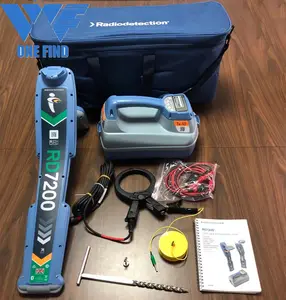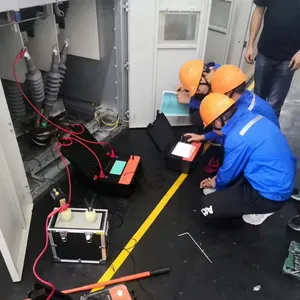

Radiodetection SPX RD7000 Series RD7200 With TX-10 Upgraded From RD7100 Underground Pipe And Cable Locator


Factory Direct Sales Technical Support Quick Safe High Voltage TDR Detection Tester Detector Underground Cable Fault Locator






Unearthing the network of underground cables can be a challenging task without the appropriate tools. Underground cable locators, with their capacity to detect buried utilities, are crucial in ensuring safety during excavation. These devices operate on two main principles: Passive Location and Active Location. This article explores the various types of underground cable locators, their working principles, and their applications. It also provides insights into the factors to consider when choosing the right cable locator for your project, along with a review of popular types and models in the market.
Underground cable locators are vital tools for detecting the presence and proximity of buried utilities. They work on the principle of detecting the electromagnetic field generated by an alternating current (AC) traveling along a cable. There are two main detection principles: Passive Location and Active Location. Passive Location involves detecting signals already present on a buried utility, while Active Location involves inducing a signal onto the utility using a signal transmitter and cable locator. These devices significantly enhance the detection process, ensuring safety during excavation.
Active locating is a method used in underground wire locators. It involves using a transmitter to impose an electric current on the cable or pipe. A receiver is then used to detect the field produced by this current. There are three types of connections, or active modes, used in active locating: direct, inductive, and inductive clamps. The direct mode generates the most current and is the most effective for localization. The inductive clamp mode generates less current but is a good option when direct access to the underground wire or pipe is not possible.
Standard Clip Direct Connection Leads are designed for everyday use, with ends featuring alligator clips for secure connection. To use these leads, connect the red cable to the conductor being located, and the black cable lead clip to a suitable ground. These leads are standard with most locator series and come with a plastic cable organizer for easy storage, ensuring their longevity.
Some Underground Cable Locators include an inductive clamp, a feature that allows non-metallic inductive connection to wires and cables, inducing a signal onto the conductor and providing a tracing signal. This feature enhances the device's versatility, making it an excellent choice for various cable tracking needs.
Many Underground Cable Locators come with a built-in inductive antenna, which is one of its key features. This antenna allows the device to transmit an easy-to-follow signal in five different selectable modes. The inductive antenna is particularly useful in the two wireless inductive modes, enabling users to locate the path of underground cables without direct connection. This feature, combined with the device's null or peak tracking options, makes it a versatile tool for locating various types of underground cables.
Passive locating is the second technique used in underground wire and pipe location. This method doesn't require a transmitter. Instead, it identifies a field formed by the current that is already circulating on the cable. Unlike active locating, which creates an electrical circuit for the current to flow through, passive locating relies on existing currents. This method is particularly useful when access to the underground pipe or wire is limited, preventing the use of active locating techniques.
Radio frequency locators are versatile tools for detecting both energized and de-energized underground cables and wires. They employ a proven frequency for most locating applications. These devices also offer highly sensitive power and radio modes, allowing them to avoid lines at utility construction sites. They feature a backlit, multiple-segment, bar graph, digital display, and audible indicators for easy cable and wire location.
Power signal locators offer a practical solution for locating underground cables, wires, and pipes. They operate on a specific frequency, which is effective for most locating applications. These devices are equipped with a backlit, multiple-segment, bar graph, digital display, and audible indicators for easy cable and wire location. They also have a depth measurement feature that can be activated with a simple button press. Power signal locators are particularly useful in utility construction sites, as they have highly sensitive power and radio modes to avoid lines.
Choosing the right type of cable locator is crucial for the success of your project. Factors to consider include the type of cables being located, the accuracy and depth range required, the soil conditions, the ease of use and portability of the equipment, and the availability of technical support and training. Understanding the specific needs of your project can help you choose the most appropriate type of cable locator.
When choosing an underground cable locator, consider the type of cables being located, the accuracy and depth range required, the soil conditions, and the ease of use and portability of the equipment. Also, consider the availability of technical support and training. These factors are crucial in ensuring the success of your cable locating project.
Several types and models of underground cable locators are available in the market. Some are suitable for both outdoor and indoor cable detection, including communication cables, power cables, and building pipeline construction. Others are heavy-duty tools ideal for outdoor use. Each of these models has unique features and applications, making them suitable for different types of cable locating tasks.
Understanding the intricacies of underground cable locators is crucial for any excavation project. From active locating devices like direct connect, inductive clamp, and inductive antenna, to passive locating devices like radio frequency and power signal locators, each type has its unique advantages and applications. The choice of the right device depends on various factors, including the type of cables being located, the required accuracy and depth range, soil conditions, and the ease of use and portability of the equipment. With a range of models available to cater to different needs, you can make an informed decision and ensure the success of your cable locating project.